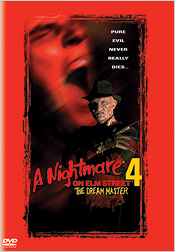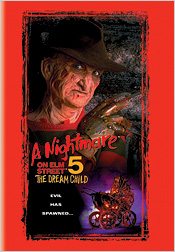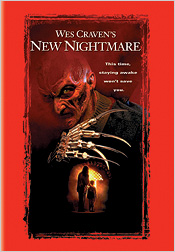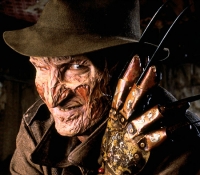A Nightmare on Elm Street 4: The Dream Master
 After the overwhelming success of Dream Warriors, New Line quickly got another sequel underway to capitalize on it. A script was quickly thrown together and Robert Shaye hesitantly hired director Renny Harlin to helm the project. Harlin managed to bring a fresher stylistic approach than previous directors that was fast, frenetic and dripping with teenage angst. It was a perfect fit, despite Shaye’s reluctance and being unsure of the young director at the time.
After the overwhelming success of Dream Warriors, New Line quickly got another sequel underway to capitalize on it. A script was quickly thrown together and Robert Shaye hesitantly hired director Renny Harlin to helm the project. Harlin managed to bring a fresher stylistic approach than previous directors that was fast, frenetic and dripping with teenage angst. It was a perfect fit, despite Shaye’s reluctance and being unsure of the young director at the time.
The Dream Master storyline brought back the three surviving dream warriors from the third film, only to be killed off within the first thirty minutes (a sort of detriment to that film really). The story also further developed the idea of Freddy needing the souls of his victims in order to thrive, except in this instance, the ‘powers’ of his victims were taken in by shy and uninteresting Alice (played wonderfully by Lisa Wilcox). By the end of the film, Alice becomes a courageous and strong young woman, giving her character a real arc (a story device that hadn’t been used in the series up to this point). There were also some very bizarre ideas utilized for the film, including the resurrection of Freddy by way of a dog urinating fire onto his resting place.
The film also combined the talents of many of the best special makeup and technical effects wizards including Jim Doyle, John Carl Buechler, Screaming Mad George, Howard Berger and Kevin Yagher, some of whom had worked on the previous films. Old school mechanical and special effects were in their prime, and whether they were being done in-camera or optically, they worked fantastically on audiences.
The only problem during the shoot was Robert Shaye’s reservations about Renny Harlin. By this point, New Line was beginning to get very protective of their biggest money maker and weren’t easily swayed when it came to new approaches and fresh ideas. Renny Harlin has stated that he was sure that he would have been fired from the project at any time because he didn’t feel that Robert Shaye had the utmost confidence in his ability to deliver a quality film that the company could sell. It didn’t really matter all that much though because Freddy’s popularity was bigger than ever, and even a bad film in the series would have made its money back no matter what. Thankfully, Harlin wasn’t relying on that and attempted to make something the Nightmare fans would embrace.
Given a summer release on August 19, 1988, The Dream Master was an enormous success. Not only that, but it was the biggest money maker of the original series and validated Renny Harlin as a talented and valuable young director to many, including Shaye. Fans came out in droves to see Freddy’s latest and were cheering him on at every turn. The character became so mainstream that it was impossible to take him seriously anymore as a dark character, something that would hurt the franchise in future entries. The Dream Master was also the first of the series to be released during New Line Cinema’s heyday as a major independent studio before becoming a major Hollywood force. Complete with their new (and now famous) logo, it was more than clear that the studio was here to stay. The success gave Renny Harlin a chance to go on and make a string of financially successful action and suspense films while giving the studio an opportunity to seek out new franchises, but the success would prove to be bittersweet for the Nightmare series.
A Nightmare on Elm Street 5: The Dream Child
 After its success, The Dream Master had the fastest turnover as far as developing a follow-up sequel in the history of the franchise. The studio was so eager to release another film they knew would make a profit that the creative process was quickly lost in the mix. An unfinished draft of a screenplay, which was written by a variety of different writers, was rushed into development and the directing reins were handed over to a young visual director named Stephen Hopkins.
After its success, The Dream Master had the fastest turnover as far as developing a follow-up sequel in the history of the franchise. The studio was so eager to release another film they knew would make a profit that the creative process was quickly lost in the mix. An unfinished draft of a screenplay, which was written by a variety of different writers, was rushed into development and the directing reins were handed over to a young visual director named Stephen Hopkins.
This time around, the franchise saw a more direct sequel to the characters from the previous film than before. Alice, Alice’s father and Dan from The Dream Master returned to reprise their roles, making Alice the only female character to survive more than one film (obviously discounting Nancy/Heather in New Nightmare, which was more of a hybrid character). Working hard to deliver a visually interesting film (perhaps the most interesting of the series), Stephen Hopkins’ background as an art director gave him more of an artistic visual edge than previous directors. Unfortunately, the story itself was both rushed and sacrificed just to get another film into theatres.
Once again the writers delved into Freddy’s backstory by bringing his mother into the forefront of the story and resurrecting Freddy through her. The convoluted story involved Freddy using Alice’s unborn child to continue invading teenager’s dreams, something which Alice put a stop to in the previous film. It was a more mature approach that dealt with issues of child abandonment, rape and abortion, which hadn’t been dealt with in the series before. In retrospect, it tends to stick out as one of the most socially-conscious entries in the franchise, but it seemed more like a David Lynch nightmare than your usual run-of-the-mill Nightmare film. However, the studio was willing to go with a fresh approach in fear of the series becoming stale.
Like the last film, The Dream Child also brought a lot of talented special effects wizards in to work on it. Freddy’s literal rebirth in the film gave the makeup artists a chance to redesign his make-up. Unfortunately, it’s the weakest and least-effective makeup job in the series, but thankfully the rest of the film’s effects are superior and highly-imaginative. Everything from rear screen projection, stop-motion animation to faux black and white photography was used to great effect. Though visually interesting, the physical effects tended to stray more into gory territory, even more so than previous entries. This caused the MPAA to come down hard on the original cut of the movie, with two key scenes becoming truncated in the final version. It didn’t help the film in the long run and left some audience members scratching their heads as to what exactly was going on during some of the dream sequences.
Released on August 11, 1989, The Dream Child saw a disappointing decline at the box office upon its release. It was technically a financial success, but it was nowhere near the hit that The Dream Master had been and wasn’t an enormous profit for the studio. It saw the poorest performance of any of the films in the series at the time and was a let-down for many of its followers. Fortunately, its aftermarket life proved to be more lucrative. When originally released on home video, the unrated version of The Dream Child was included which featured all of the graphic footage that the MPAA had made the filmmakers cut out to get an R rating reinstated. As of this writing, that footage has yet to be included in future DVD releases.
Meanwhile, New Line Cinema was busy pursuing different avenues to find worthy new film properties, including chasing the rights to the Friday the 13th series from Paramount Pictures. Between the studio’s involvement with other promising directions and The Dream Child’s lackluster box office performance, it was decided to end the series with one final entry.
Freddy’s Dead: The Final Nightmare
 Two years would go by before Freddy would make a return to the big screen. Story treatments for the sixth sequel were being handed in by the likes of people like Peter Jackson, but it was the screenplay by Michael De Luca and Rachel Talalay that got the studio excited the most. Signing on to direct, Rachel had been a very small part of the series from the very beginning, starting out as little more than a production accountant. Having worked her way up the ranks to the director’s chair, she was determined to send the series out on a high note.
Two years would go by before Freddy would make a return to the big screen. Story treatments for the sixth sequel were being handed in by the likes of people like Peter Jackson, but it was the screenplay by Michael De Luca and Rachel Talalay that got the studio excited the most. Signing on to direct, Rachel had been a very small part of the series from the very beginning, starting out as little more than a production accountant. Having worked her way up the ranks to the director’s chair, she was determined to send the series out on a high note.
The approach to The Final Nightmare was to make it a less serious film and more of a fun, bizarre ride. Twin Peaks had the heaviest influence on the film, as did the work of John Waters. Featuring cameos from the likes of Roseanne Barr, Tom Arnold and Alice Cooper, it was a chance to have some fun with the story after the previous film’s dark, gothic overtones. Hoping to hook audiences with a gimmick after the disappointing box office figures from The Dream Child, it was also decided that the final portion of the film would be filmed in 3D. Although it worked for the most part, story and effects elements were downplayed in order to achieve it, which is a mistake Rachel has often commented on.
The Final Nightmare was also the least direct sequel of the franchise. Taking place sometime in the future when Springwood has been wiped clean of anyone under 20, it featured absolutely none of the characters from the previous films, except for Freddy himself. In the final installment, Freddy has run out of teenagers in Springwood and is looking to jump ship. The only way he can do that is through his daughter. He sends the character of John, the last remaining teenager from Springwood with a bad case of amnesia, out into the world to find her. Unfortunately, Rachel’s quirky style displeased a lot of the fan base while Freddy’s demise seemed to walk down familiar territory, making it more of a joke than enthralling to most fans.
The Final Nightmare also featured a lot of new young talent like Breckin Meyer and Ricky Dean Logan, the latter of whom went on to be a successful character actor. There was also a bit of gravitas given to the film in the lead roles with Lisa Zane and veteran Yaphet Kotto. The film was also one of the few entries in the series that had the most additional footage hit the cutting room floor. Bootlegs of this footage have been floating around for years but none of it has yet to make any official releases. With a wealth of great talent both behind and in front of the camera, it was also one of the easiest and most trouble-free shoots of the series. The biggest headaches stemmed from the filmmakers trying to get the 3D to work properly, but they would soon find out if it would pay off or not.
Released on September 13, 1991, The Final Nightmare was released to slightly more enthusiastic response than its predecessor. Fans happily turned up for Freddy’s supposed final bow, but it wasn’t without its drawbacks. Still lacking the kind of box office draw that New Line was hoping for, the series truly died with this film. It was very much a ‘Twin Peaks meets Looney Tunes’ sort of horror film and fans were generally displeased with the results, citing it as one of, if not THE, worst of the series. To add insult to injury, when it was originally released on home video, the 3D portion was removed due to the limitations of the format. What was leftover were actors sticking objects awkwardly at the camera lens trying to make the 3D work. Although it was released on Laserdisc, the original version of the film wasn’t seen by most home-viewing audiences until almost eight years later when it was released on DVD in New Line’s Nightmare series boxed set (with 3D glasses thrown in for good measure).
It’s almost sad to think that the series really ended the way it did, without its creator coming back for one last stab (pun intended) at bringing Freddy Krueger back to his roots. It might have been a lost cause due to the character’s popularity and how overexposed he had become, but unfortunately (or fortunately, depending on how you look at it), the original storyline would never see another entry... but it wasn’t the last time that we would be seeing Freddy.
Wes Craven’s New Nightmare
 Three years after Freddy’s final curtain call, New Line felt comfortable enough in bringing back the character for one more film. Most people scoffed at the idea and made a joke out of it because of how much the studio went out of their way to declare the series finished. However, the studio treated the idea with respect and wasn’t interested in making just another sequel. The strained relationship between Robert Shaye (now a major studio executive) and the series’ creator Wes Craven was finally ended in one fateful meeting. Shaye was happy to work with Craven in developing a new story for the series and gave him carte blanche to create something that he could call his own, which excited Craven enough to write and direct the project.
Three years after Freddy’s final curtain call, New Line felt comfortable enough in bringing back the character for one more film. Most people scoffed at the idea and made a joke out of it because of how much the studio went out of their way to declare the series finished. However, the studio treated the idea with respect and wasn’t interested in making just another sequel. The strained relationship between Robert Shaye (now a major studio executive) and the series’ creator Wes Craven was finally ended in one fateful meeting. Shaye was happy to work with Craven in developing a new story for the series and gave him carte blanche to create something that he could call his own, which excited Craven enough to write and direct the project.
After reviewing the entire series from beginning to end, Craven decided to abandon the series’ storyline completely and jump outside of the films altogether, exploring the effects of it on the people who were a part of the original film. The idea was that Freddy, as portrayed in the film, would be the evil that has escaped into the real world and that Craven’s mission within the film is to write another sequel to keep the evil out of reality. Meanwhile, Heather Langenkamp is being terrorized by this evil and her mission is to save herself and her son. It was a very bold move to go in such a radical new direction, but Craven was determined to make a horror film that carried a more meaningful message. That message, which would be explored further in the Scream series much later, was aimed directly at the critics who blamed horror films for all of the negativity taking place in the real world. Nearly all of the actors from the original film would also be brought back for both leads and cameos, but to more or less portray themselves.
New Nightmare was also the first of the franchise to make a more apparent use of computer generated special effects with the practical effects taking a back seat. It was sort of a detriment in a way, but thankfully those effects were not gratuitous and had a purpose in the storytelling. The biggest miscalculation, however, was Freddy’s new look. To give the character a new identity as a pure agent of evil, his design was redeveloped to look bulkier and even more sinister than before. This included having blades that came out of all four fingers plus his thumb instead of using his trademarked razor glove, as well as transforming into a demon at one point. It’s a flaw that Wes Craven admits wasn’t the best idea, but it served its purpose to make Freddy unique instead of a carbon copy of what we had seen before.
Released on November 9, 1994, ten years after the original film, Wes Craven’s New Nightmare turned out to be the very first film in the franchise to be received well critically. Unfortunately, the box office figures weren’t on the same page. Returning its budget but failing to capture the kind of popularity the previous films had seen, New Nightmare became the least successful film of the entire franchise. Some fans felt that it was demeaning to Freddy’s character to take him out of the original series and make him symbolic. Others felt that the story just wasn’t interesting enough to explore in the first place. Despite this, the film has had a strong aftermarket life on home video and is considered by many to be an extremely smart and effective horror film on its own.
The Nightmare series then went into a slumber and lay dormant for well over a decade as New Line Cinema moved on to other promising properties. They were, by this point, a major Hollywood studio with other hugely successful films and franchises under their belt including Blade, Se7en, Rush Hour, Austin Powers, Teenage Mutant Ninja Turtles, The Mask, Friday, and of course, the biggest success the studio has ever had, The Lord of the Rings franchise. As for Craven, he moved on from Freddy and found mainstream success with the extremely successful Scream franchise through Miramax, but continues to acknowledge A Nightmare on Elm Street as his greatest triumph.




